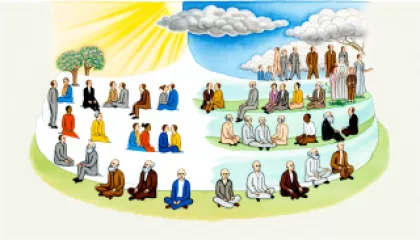A Beginner's Guide to Starting Drama Therapy
11 months ago
Drama Therapy
Drama therapy is a therapeutic approach that uses theatrical techniques to promote psychological healing and growth. As a beginner, starting drama therapy might seem challenging due to its unique blend of arts and psychology. However, the process can be simplified by understanding the core concepts and steps needed to get started. This guide is designed to walk you through the process of drama therapy, from understanding its principles to implementing therapeutic techniques.Understanding Drama TherapyDrama therapy is an expressive form of therapy that aims to facilitate personal growth and promote mental health by using action methods, primarily dramatic action. Its roots trace back to the early 20th century, when J.L. Moreno developed psychodrama, a method of psychotherapy wherein patients act out their experiences.Today, drama therapy is a recognized form of treatment used in various settings, including hospitals, schools, and mental health facilities. It can be used to treat a wide range of issues such as anxiety, depression, trauma, and behavioral disorders. Step 1: Educate Yourself About Drama TherapyThe first step to starting drama therapy is gaining a comprehensive understanding of the field. This includes learning about the theoretical underpinnings of drama therapy, different approaches and techniques used, and the benefits it can offer. There are numerous resources available online, including articles, webinars, and e-books on the subject.Step 2: Find a Qualified Drama TherapistDrama therapy should be conducted by a professional who has been trained in this specialty. Look for someone who holds a master's degree or higher in counseling or psychology, with additional training in drama therapy. In some countries, drama therapists must also be registered or licensed by a professional body.Step 3: Attend Your First SessionYour initial session will typically involve an assessment where the therapist learns more about your needs and goals. You may be asked to participate in various drama exercises or games, which serve as an introduction to the therapy process. Remember, the aim is not to perform but to express and explore personal issues.Step 4: Participate ActivelyIn drama therapy, active participation is key. This might involve role-play, improvisation, storytelling, puppetry, or mask work. Remember, the purpose is not to put on a performance, but to use drama as a vehicle for self-exploration and understanding.Step 5: Reflect on Your ExperienceReflection is a critical part of the therapeutic process. After each session, take some time to reflect on what you explored during your session. This self-reflection can enhance your understanding of yourself and contribute to your personal growth.Step 6: Maintain RegularityRegular attendance is crucial in drama therapy. Consistency helps build a therapeutic alliance with your therapist and allows for continuous growth and development. It also ensures that the therapeutic benefits are sustained.The Role of the Drama TherapistA drama therapist acts as a guide, helping you navigate your emotional landscape through the medium of drama. They create a safe and supportive environment where you can express yourself freely. Through their professional training, they can help you gain insight into your emotions, thoughts, and behaviors and assist you in finding healthier ways to cope with life's challenges.ConclusionStarting drama therapy can be a transformative journey towards self-discovery and healing. Understanding the process and actively participating can significantly enhance the therapeutic experience. Remember, the goal isn't to become a great actor but to use the dramatic process as a tool for personal growth and mental well-being. So, step into the world of drama therapy, and discover its therapeutic power for yourself.
Deciphering Our Emotional Weather: A Perspective on Understanding Moods
11 months ago
Understanding Moods
Our emotions are as unpredictable as the weather. They can shift from tranquil calm to turbulent storm in an instant, like a sudden downpour on a sunny afternoon. We are all subject to our emotional weather patterns, and understanding these patterns is the key to navigating our internal landscapes with grace and resilience.Emotions as WeatherBefore we delve into the intricacies of understanding moods, it's important to establish a fundamental analogy: emotions as weather. Why is this analogy apt? Emotions, much like weather, are transient. They come and go, change unpredictably and are never static. They are also impartial - they don't discriminate in their occurrence, affecting everyone regardless of age, gender, socio-economic status or ethnicity. To understand our moods, we need to first appreciate this ebb and flow, accepting that emotions are not something to control, but rather observe, understand, and navigate.The Components of Our Emotional WeatherJust as weather has multiple components like temperature, precipitation, wind speed, and atmospheric pressure, our emotional weather is also composed of various elements. The basic emotions - happiness, sadness, fear, anger, surprise, and disgust - act like the primary colors of our emotional palette. Our moods are often complex blends of these basic hues, creating a spectrum of feelings ranging from contentment to despair.Happiness and SadnessHappiness is like sunshine, brightening our inner world, while sadness mimics the gloom of an overcast day. However, it is important to note that both are essential. Just as plants require both sunlight and rain to grow, our emotional health requires a balance of happiness and sadness. It's unrealistic and unhealthy to aspire to a perpetually sunny internal climate. Rainy days are necessary, allowing for introspection and growth.Fear and AngerFear is akin to a thunderstorm, stirring up anxiety and unrest. It often signals danger, much like storm warnings prompt us to take shelter. Anger, on the other hand, resembles a wild fire, burning with intensity and capable of causing destruction if not managed properly. However, it can also serve as a catalyst for change, sparking action where there was previously stagnation.Surprise and DisgustSurprise mirrors a sudden weather change, catching us off guard and triggering a range of reactions. It may be a welcome respite or an unwelcome disruption, depending on the context. Disgust is like a toxic smog, a reaction to something offensive or repellent in our environment.Understanding Our Emotional ClimateWhile weather is a short-term phenomenon, climate refers to the long-term patterns. Similarly, our emotional climate is the general mood that characterizes our life over long periods. Some people have a predominantly sunny disposition, while others might have a more cloudy emotional climate. Understanding our emotional climate can help us identify patterns, triggers, and coping mechanisms, leading to improved emotional health.Identifying PatternsJust as meteorologists study weather patterns to predict future conditions, we can observe our emotional patterns to better anticipate and manage our moods. By regularly checking in with ourselves and tracking our feelings, we can start to notice recurring themes and patterns. This self-awareness can provide valuable insights into our emotional wellbeing.Recognizing TriggersWeather changes are often triggered by specific environmental factors. Similarly, our moods can be influenced by various factors in our environment - a stressful day at work, a conflict with a loved one, or even lack of sleep can trigger emotional shifts. Recognizing these triggers is crucial to managing our emotional weather effectively.Developing Coping MechanismsJust as we take measures to protect ourselves from adverse weather conditions, we can develop coping mechanisms to navigate our emotional storms. This could be anything from practicing mindfulness to seeking support from loved ones or professionals. The key is to cultivate a toolkit of strategies that work best for you.In Conclusion: Embracing Our Emotional WeatherIn conclusion, understanding our moods is a journey of self-discovery and acceptance. It's about embracing the full spectrum of our emotional weather, from the sunniest days to the stormiest nights. It's about realizing that it's okay to not feel okay sometimes and that every mood, like weather, is temporary. With this understanding, we can navigate our emotional landscapes with greater ease and resilience, fostering a healthier relationship with ourselves.Remember, without weather, our world would be a barren, lifeless place. In the same way, without emotions, we would be devoid of the experiences that shape us, guide us, and ultimately, make us human. So, let's embrace our emotional weather in all its unpredictability and beauty, for it adds color, depth, and richness to the tapestry of our lives.


